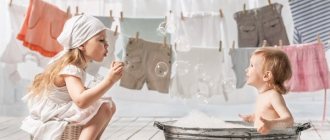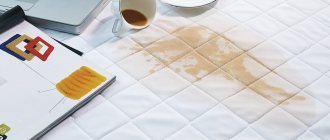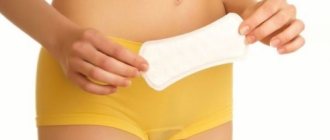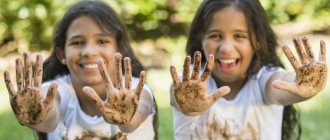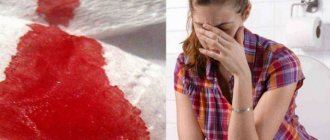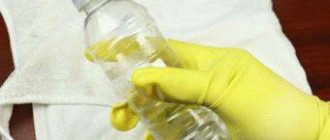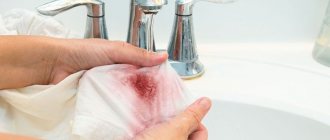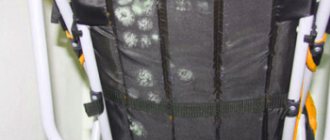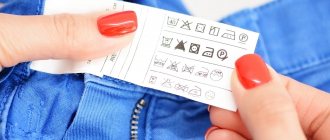The appearance of various stains on children's clothing is considered an absolutely normal phenomenon, which will not surprise any modern mother. Children, in the process of their growth and development, actively become acquainted with the world around them. Therefore, dirt appears on their things in the form of stains from grass, paint, juice, fruits, vegetables and other traces that various foods can leave on children's clothes. But there are times when seasonal items, which are put away in a storage closet for a long period, suddenly appear difficult to remove stains that cannot be removed during normal washing. Therefore, every good mother should know how to wash stains on children’s clothing, how to get rid of fresh and old stains in order to preserve the child’s favorite item of clothing and not cause an allergic reaction on the child’s delicate skin.
What not to use for washing children's clothes
A child's skin is very sensitive to synthetic components contained in modern chemical powders. It is strictly forbidden to use ordinary powders for washing children's clothes - they contain substances that are potentially dangerous to the child's skin.
When choosing a bleach, you should focus on products that do not contain chlorine. It is poorly washed out of fabric and causes an allergic reaction.
Children's clothes should not be washed, as powder particles will remain on one part of the clothing, and bacteria on the rest. You can give baby clothes freshness and softness with the help of conditioner, but it is important that it does not have a strong odor.
Choosing the right cleaning products
Washing powders, gels, rinse aids and soaps are also intended for children's clothes, but their difference lies in their less aggressiveness and gentle composition. Since parents are constantly in contact with the child, their clothes should also be washed using children’s products, but separately.
When choosing a product, pay attention to the presence of the line “from the first days of life.” Such an inscription is a guarantee that the products were thoroughly tested in production, taking into account strict selection criteria. This purchase will help you quickly and carefully remove any stains.
Don’t be lazy to read and decipher the composition, even if it is written in very small print and is not always clear. The composition should not include aggressive substances. Otherwise, skin allergies may occur upon contact with the child's skin. The baby's skin is delicate and thin, so it requires careful treatment.
It is desirable that the composition contains natural soap. This powder will produce less foam and will be washed off well with water. And in no case should you give preference to powders containing phosphates.
As for the fabric softener, it should be taken without strong odors and fragrances. Remember that your baby's sense of smell is much more sensitive than yours. Even if you like the scent of the product, it can harm your child.
Chemical stain removers for children's clothing
Stain removers developed for children's clothing contain safe ingredients and a hypoallergenic formula. These include:
- Soap “Eared Nyan” with whitening effect. It does not cause allergies and is suitable for washing newborn clothes. It has a natural base and, thanks to the glycerin in its composition, does not dry out the skin of the hands. The product is able to remove any dirt and maintain the whiteness of the fabric.
- “Umka” is a children’s stain remover that contains natural ingredients of plant origin. Able to wash clothes even at low temperatures, and also enhance the effect of washing powder. It is completely rinsed from the fabric and does not destroy its structure.
- Domax Baby Care is a stain remover without dyes or active bleaches. Quickly removes stubborn stains. Apply the product using a sponge, and after 20 minutes begin washing. Domax can be used for both white and colored items.
- “Our Mother” is a stain remover with a dispenser for easy application. Suitable for different types of fabric, safe for newborns. The composition does not contain chlorine or other solvents. Apply the product to the stain 15 minutes before washing, and then rinse the clothes again.
Lifehacks
Life hacks for every day, as well as a review of proven and necessary products for the whole family.
How to remove old stains from children's clothes
Sooner or later, various stains appear on children's clothes. Children actively explore the world around them, so traces of food, gouache, juice and vegetables are absolutely normal. If children's clothes lie in the closet for a long time, then old yellow stains may also appear on them. Such stains cannot be removed by regular washing.
We will tell you how to remove old stains from children's clothes at home.
How to remove old yellow stains from baby clothes
There are several ways to remove old yellow stains from children's clothes:
In addition to vegetable oil, you can also add a tablespoon of 90% vinegar to definitely remove stains on children's clothing.
To enhance the effect, apply the mixture on both the front and back sides.
How to wash children's clothes from fruit and berry stains
Old stains from berries, fruits and vegetables are not so easy to remove by regular washing. Use a few simple methods to help you remove stains from children's clothing at home:
Treat stains with aggressive products from the inside out so as not to ruin your clothes. This method should not be used for delicate and thin fabrics.
How to remove old stains on white children's clothing
Many mothers are concerned with the question: “How to remove stubborn stains from white children's clothes? You can try some simple and famous methods:
Remember, no matter what method you choose to remove stains, you should always rinse baby clothes thoroughly so that no smell or traces of the substances used remain on them. Use special hypoallergenic soap and powder for children's clothes to wash children's clothes.
Now you know how easy it is to remove old stains from children's clothes.
What methods do you usually use to remove old stains?
How to get rid of stains on white and light-colored fabric
Stains on light-colored linen are removed using hydrogen peroxide or potassium permanganate.
Before starting the procedure, testing is carried out on a hidden area of tissue. This is done in order to check how the fabric reacts to the product.
There are several methods for washing light-colored clothes:
- 2 teaspoons of peroxide are poured onto the contaminated area, and then carefully ironed with a hot iron.
- The contaminated area is treated with lemon juice and left for 2 hours.
- Mix hydrogen peroxide and ammonia in equal proportions - 1 teaspoon each. The solution is applied to the stain and left for 15 minutes.
Instead of lemon juice, you can use citric acid. 0.5 teaspoons of acid are diluted in 1 teaspoon of boiling water. The resulting mixture is applied to the contaminated area, and then sprinkled with soda on top.
The item is left for 15 minutes and only then washed. After treatment, items are washed in the usual way.
How to remove soap bubble stains
No matter how trivial it may sound, ordinary water will come to the rescue here. The item stained with bubbles must be rubbed under running water, only then will they begin to wash off. If this doesn't help, soak it in a bowl of hot water. You can also add a little lemon juice there.
After washing, the stains are still there - if the fabric is delicate, use Nefras or any other bleach. Apply the product pointwise (only to stained areas) and leave for 20 minutes.
Removing old yellow spots
In a separate container mix 150 grams of washing powder, 2 tbsp. spoons of bleach without chlorine and 2 tbsp. spoons of sunflower oil. If you have a stain remover on hand, add it in the same quantity.
The resulting composition is mixed with 5 liters of warm water and contaminated items are dipped into it. The clothes are left to soak for 12 hours. The next day, the laundry is washed in the usual way.
Some housewives slightly change this method by additionally adding 2 tbsp to the solution. spoons of vinegar.
You can use one more method. Mix 10 ml in a separate container. hydrogen peroxide, 1 teaspoon of dishwashing detergent and 1.5 teaspoons of soda. The result is a thick paste.
The paste is applied to the stains, rubbed a little, and left for 30 minutes. After half an hour, the fabric should be lightly rubbed again and the item should be washed with powder with added stain remover.
Stains that appear after long-term storage can be removed with glycerin. A small amount of this substance is heated in a water bath and diluted with the same amount of water.
Moisten the stained area with the resulting solution and leave for 15 minutes. After this, the item is washed in the usual way.
Remove stubborn stains from purees, juices and food
Sometimes it seems to young parents that it is easier to buy new things for the child than to remove yellow stains from mashed potatoes or feces on old clothes. However, the following “grandmother’s” advice can prove the fallacy of this opinion.
9% table vinegar
Dilute a few tablespoons of vinegar in 1 liter of hot water and soak baby clothes in it. Wait at least 1 hour, then wash the items in the machine.
Information. As reviews show, most mothers use vinegar to quickly remove stubborn stains on children's clothes.
Laundry soap and boiling
Sometimes, in order to remove long-standing urine stains on panties, you should resort to such an old method as boiling. Laundry soap will help make the method more effective:
- And to do this, finely chop ¼ of a bar of soap with a knife and add it to the water that is on the fire;
- As soon as the liquid boils, put all children's things stained with yellow or other stains into a basin or bucket;
- Using wooden tongs or a spatula, continually immerse the items in the water to make the boiling process more efficient;
- Treat the stains with this product for at least 1 hour, then wash the items in the machine.
Vinegar and soda
You can also remove stubborn stains of various origins using baking soda, which is applied to the stains after vinegar.
- But first, table vinegar should be diluted with water in a ratio of 1:3.
- Soak all the stains in the resulting solution and immediately, without waiting for them to dry, sprinkle them with soda.
- Wait at least 1 hour and then wash the items.
Old fruit and berry stains
You can remove fresh stains from berries and fruits with laundry soap. The item is washed by hand and then rinsed in warm water.
If the stains have already dried, then other washing methods are used:
- Vinegar. 4 tbsp. spoons of 9% vinegar are diluted in 1 liter of warm water. Children's clothes are soaked in the resulting solution for at least 1 hour.
- Lemon acid. 1 tbsp. A spoonful of acid is mixed with 1 liter of water. Soak baby clothes in the solution for 30 minutes. After half an hour, the laundry is washed by hand in warm water with the addition of powder. This method is great for removing stains from bananas and apples.
In difficult cases, when available means fail, they resort to more aggressive substances: turpentine or gasoline. It is enough to moisten a cotton pad in the selected substance and treat the problem area with rubbing movements, from the edges to the center.
To remove old marks from berries, mix 1 teaspoon of warm medical alcohol and 0.5 teaspoon of citric acid in a container. The resulting paste is applied to the stains and wait 15-20 minutes.
Features of manual care
Washing baby clothes by hand is a complex and multi-step process that involves:
- pre-soaking the product in warm water;
- applying, if necessary, a ready-made stain remover or folk remedies;
- washing clothes according to the instructions on the label;
- high-quality rinsing.
Before washing baby clothes by hand, you need to soak them in warm soapy water for several hours. For cotton or linen, hot soaking is perfectly acceptable, but with delicate fabrics this should be avoided. At the end of the process, the products are removed, squeezed out a little, and a stain remover is applied to the stains - Eared Nyan, Stork, Buggy. Folk remedies are also suitable: a mixture of soda and vinegar, mustard powder, toothpaste.
Avoid excessively rubbing or twisting your child's belongings. Most products now add viscose, which easily loses its shape if not properly cared for. For dense materials, soft-bristled brushes can be used to remove stains. In addition, special boards can simplify the task. However, the latter significantly reduce the service life of the product.
It is very important to thoroughly rinse children's clothes after washing. Residue from soap or powder may irritate the skin or cause difficulty breathing for the child. The best results can be achieved by alternating cold and hot water.
Grease stains on children's clothing
Dishwashing liquid works well with them. After the procedure, you must wash the item in the machine so as not to harm the child’s health.
There are several other ways to remove grease stains:
- It is necessary to wet the stain with water and then rub it with laundry soap. After this, sprinkle with sugar and rub the dirt with a stiff brush.
- If the fat is still fresh, then sprinkle a little salt on it and rub it into the fabric with a brush. After some time, the stain will dissolve.
- The grease stain is sprinkled with talcum powder, the mark is ironed through a paper towel, and then pressure is placed on it for several hours.
- The greasy mark is rubbed with laundry soap and left for 2-4 hours. To prevent the soap from drying out during this time, place the item in a plastic bag. After time, the stain will dissolve.
Old and ingrained traces of fat are also eliminated with aggressive substances.
For example, shavings of ordinary soap are added to a solution of ammonia and turpentine mixed in a 2:1 ratio. The resulting composition is rubbed into the dirt, and then the item is washed with powder.
Selecting a washing mode
Modern washing machines have special modes designed to care for baby clothes. They combine high temperatures, moderate speeds and a long cycle. If there is no such mode, then you can consider one of the following:
- "cotton";
- "sports things";
- “linen or natural fabrics”;
- "boiling".
The “clap” mode has all the necessary parameters. It involves the use of hot water, pre-soaking, intensive washing and is perfect for caring for the things of a newborn baby or baby. An alternative way to get rid of dirt is to set the “sports items” mode. It is designed to get rid of old and stubborn stains, easily overcomes unpleasant odors and is gentle on things. “Linen” and “natural fabrics” also belong to high-temperature programs. The “boiling” mode also ensures thorough washing of your baby’s clothes.
How to remove chocolate from children's clothes
You can remove both fresh chocolate stains and old marks from children's clothes:
- Apply laundry soap or dishwashing detergent to the stain, wait 20-30 minutes and rinse with water.
- In a separate container mix 1 tbsp. a spoonful of ammonia and 100 ml of warm water. Dip the contaminated area into the solution and wait until the stain begins to blur. After this, the item is washed again in the usual way.
- If you treat the area stained with chocolate with hydrogen peroxide and wait 15 minutes, the stain will completely disappear.
For linen or cotton products, a different cleaning method is used. Mix 2 teaspoons of table salt with half a glass of warm water. The solution is used to treat chocolate marks until they disappear completely.
Cleanliness and freshness are easy
Parents want to see their children not only neat and neatly dressed, but also cheerful, active and sociable.
Excessive comments sometimes help solve the first problem, but at the same time negate such important qualities of the child as sociability and cheerfulness, openness to new and interesting things.
Knowing how to deal with troubles - dirt and numerous damages caused to children's clothing - will allow you not to spoil your child's mood for no reason, but to simply and quickly deal with the problem that has arisen.
Should I wash new clothes for my baby?
Newborn babies are very vulnerable to external factors, microorganisms and bacteria. Your task is to protect the baby as much as possible from such influences.
Pay utmost attention to new things that, although not visibly dirty, may still contain particles of dust and bacteria. You cannot be sure that diapers, rompers and baby vests were stored in proper conditions and were not soiled during sale. In addition, to make them look presentable, some manufacturers sprinkle their products with starch, which can cause skin irritation.
When can you start using regular powder?
It is advisable to wash all of your baby’s clothes with a special baby detergent for at least 6 months. If the child has not experienced skin reactions during this period, you can gradually switch to regular powder containing bioregulators, activators and neutralizers for hard water.
To check your baby’s skin reaction to a new product, soak one baby item in the “adult” powder, rinse thoroughly and dry. If the baby has no visible reactions while wearing these clothes, then the powder is suitable.
What to do if nothing helps
The modern chemical industry offers a huge range of household chemicals. But not everyone trusts such compounds: they cause allergies and sometimes do not give the expected effect.
Before you begin, you need to determine the type of fabric and the origin of the stain:
- Stains from red wine, fresh berries and juices can be cleaned using a mixture of egg yolk and glycerin. The mixture should be applied to the problem area, left for one and a half to two hours and washed with laundry soap.
- You can remove stains from light-colored items made from delicate fabrics with a mixture of 10 parts white laundry soap, 2 parts turpentine and 1 part ammonia. First, the product needs to be soaked with detergent for several hours, and then the problem areas should be generously moistened with the prepared mixture and washed in a machine.
- Blood or chocolate stains can be smeared with a paste of potato starch and water. The applied mixture should dry, and then it should be washed off with warm water and soap.
Traditional methods of lightening
You can also bleach white children's clothes at home using “folk” remedies. These include pharmaceutical drugs and products that can be found in any kitchen. They are used individually or made into mixtures to enhance the brightening effect. What medications from your home medicine cabinet will remove yellowness and gray plaque?
- Aspirin. The drug is broken into powder and dissolved in hot water. For 1 liter of liquid you will need from 1 to 4 tablets, depending on the condition of the item. When the solution has cooled to 35°, add powder to it, put on clothes and leave for 2-6 hours.
- Potassium permanganate. Prepare a rich-colored solution in a glass of water, then filter it through cheesecloth to get rid of sediment, if any. The clarifier is poured into a filled basin (the color of the water should turn pale pink), and the products are kept in the resulting solution for half an hour.
- Boric acid. 3 tbsp. l. The drug is poured into a basin with 6 liters of water at room temperature. Children's clothes are bleached in the resulting mixture for 2-4 hours.
- 3% peroxide. 6 tbsp. l. The substances are mixed with 3 liters of water. Grayed (yellowed) wardrobe items are kept in the clarifier for half an hour. During soaking, you need to turn things over several times and make sure that they are completely immersed in water. Otherwise, unbleached areas of the fabric may remain.
No less effective and the most gentle are natural bleaches from the kitchen. They are used individually and in mixtures with detergents and medicinal substances.
- Salt. For 6 liters of water add 6 tbsp. l. substances and prepare a solution. Pre-washed items are kept in it for 3-4 hours. To enhance the bleaching effect, add 2 tbsp to the basin. l. peroxide.
- Soda. Add 12 tbsp to 6 liters of liquid. l. soda and leave the laundry in the solution for 6-8 hours.
- Lemon acid. The crystals are dissolved in hot water and the mixture is poured into a washing container (1 teaspoon of substance for each liter of liquid). Pre-washed clothes are kept in the brightener for about 1 hour.
- Low-fat milk. Typically used for children's clothing made of delicate fabrics (guipure, cambric, silk). The milk is heated to room temperature and the item is bleached in it for half an hour to 3 hours.
The treated product is rinsed twice: first in warm and then in cold water. To prevent possible contact of brightener particles with the child's skin, it is recommended to wash the items again.
Tips and tricks
- No matter which method of cleaning things from yellow stains you choose, it is important to remember that after this, children's clothes must be thoroughly rinsed and washed using hypoallergenic powders.
- It is necessary to dry clothes in the open air; the sun will help prevent the appearance of unpleasant odors.
- Ventilate the closets in which you store children's clothes; it is also recommended to clean them at least once every six months.
- In winter, clothes can be hung out in the cold, which will give them a feeling of freshness and save you from problems with unpleasant odors.
If you use the methods for cleaning clothes that we have given above, and also follow the tips, then you will not have to constantly change your child’s clothes; they will always look neat and clean.
Was the article helpful?
Rate the material on a five-point scale!
( 2 ratings, average: 4.50 out of 5) If you have any questions or want to share your opinion or experience, write a comment below.
How to soften your baby's underwear after washing
Do not use fabric conditioners or fabric softeners. Such products contain phosphates and other chemical compounds harmful to the baby’s delicate skin. To soften baby clothes before wearing them, iron them on both sides by selecting the steam mode on the iron. Modern automatic washing machines can handle heavy stains, so it is not necessary to pre-wash your clothes.
